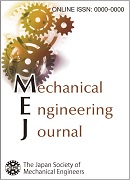Volume 8, Issue 1
Displaying 1-13 of 13 articles from this issue
- |<
- <
- 1
- >
- >|
Solid Mechanics and Materials Engineering
-
2021 Volume 8 Issue 1 Pages 20-00331
Published: 2021
Released on J-STAGE: February 15, 2021
Advance online publication: November 13, 2020Download PDF (2651K)
Thermal, Engine and Power Engineering
-
2021 Volume 8 Issue 1 Pages 20-00391
Published: 2021
Released on J-STAGE: February 15, 2021
Advance online publication: January 12, 2021Download PDF (1925K)
Dynamics & Control, Robotics & Mechatronics
-
2021 Volume 8 Issue 1 Pages 20-00299
Published: 2021
Released on J-STAGE: February 15, 2021
Advance online publication: November 25, 2020Download PDF (2931K) -
2021 Volume 8 Issue 1 Pages 20-00361
Published: 2021
Released on J-STAGE: February 15, 2021
Advance online publication: December 04, 2020Download PDF (1243K) -
2021 Volume 8 Issue 1 Pages 20-00417
Published: 2021
Released on J-STAGE: February 15, 2021
Advance online publication: January 14, 2021Download PDF (1474K) -
2021 Volume 8 Issue 1 Pages 20-00459
Published: 2021
Released on J-STAGE: February 15, 2021
Advance online publication: February 11, 2021Download PDF (2621K)
Micro / Nano Science and Technology
-
2021 Volume 8 Issue 1 Pages 20-00254
Published: 2021
Released on J-STAGE: February 15, 2021
Advance online publication: November 18, 2020Download PDF (4930K)
Computational Mechanics
-
2021 Volume 8 Issue 1 Pages 20-00364
Published: 2021
Released on J-STAGE: February 15, 2021
Advance online publication: December 22, 2020Download PDF (6796K)
Design, Machine Element & Tribology, Information & Intelligent Technology, Manufacturing, and Systems
-
2021 Volume 8 Issue 1 Pages 20-00362
Published: 2021
Released on J-STAGE: February 15, 2021
Advance online publication: November 11, 2020Download PDF (3195K)
Bio, Medical, Sports and Human Engineering
-
2021 Volume 8 Issue 1 Pages 20-00277
Published: 2021
Released on J-STAGE: February 15, 2021
Advance online publication: November 26, 2020Download PDF (1783K) -
2021 Volume 8 Issue 1 Pages 20-00406
Published: 2021
Released on J-STAGE: February 15, 2021
Advance online publication: December 15, 2020Download PDF (1683K) -
2021 Volume 8 Issue 1 Pages 20-00500
Published: 2021
Released on J-STAGE: February 15, 2021
Advance online publication: February 08, 2021Download PDF (1569K)
Transportation and Logistics
-
2021 Volume 8 Issue 1 Pages 19-00368
Published: 2021
Released on J-STAGE: February 15, 2021
Advance online publication: January 15, 2021Download PDF (2132K)
- |<
- <
- 1
- >
- >|
